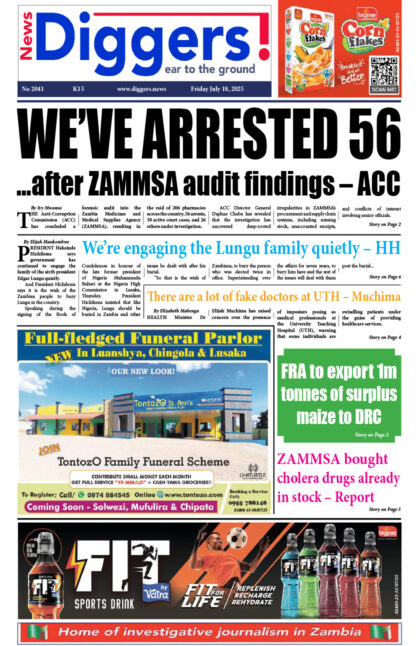PF Secretary General Davies Mwila has called on the media fraternity in the country to help demystify nuclear science technology to help correct the misconception that it is usually used for dangerous purposes.
And Mwila says to enhance electricity generation and supply, government has invested in the development of energy infrastructure, which led to the addition of 2,000 MW of hydro and thermal power to the national grid last year.
In PF’s weekly newsletter to News Diggers! Mwila has called on the media fraternity in Zambia to help demystify nuclear science technology to help correct the misconception that it is usually used for dangerous purposes.
He explained government had signed four MoUs with Russia’s ROSATOM for a period of 15 years to transform Zambia into a hub of nuclear science for peaceful purposes with a view to transforming Zambia into a hub of nuclear science.
He added that if that undertaking was to succeed, the media had to help demystify nuclear science because there was a wrong perception that all things nuclear were dangerous.
“All the four MoUs are aimed at: training young Zambian nuclear energy engineers; planning for nuclear power plant personnel; developing a nuclear energy regulator as well as building a nuclear plant, which shall provide medical and agricultural services and energy. However, if this undertaking is to succeed, then the country’s media has to help demystify nuclear science because there is a wrong, yet deeply-entrenched perception, that all things nuclear are bad and dangerous,” Mwila explained.
He noted that the Seventh National Development Plan (7NDP) in attaining the Vision 2030 goals had prioritized the implementation of specific strategies to attain core outcomes that would, among other things, lead to improved energy production and distribution for sustainable development.
“The 7NDP has thus diagnosed the weaknesses, which have plagued Zambia’s energy sector and hindered economic diversification, namely: inadequate and delayed investments in electricity generation and transmission infrastructure; the failure to diversify energy generation sources for over 30 years; historic inadequate incentives to attract private investment in the energy sector, and climate change challenges,” Mwila stated.
And he noted that in order to enhance the generation, transmission and supply of electricity in Zambia, the PF government had significantly invested in the development of energy infrastructure, which led to the addition of 2,000 MW of hydro and thermal power to the national grid in 2018.
“The PF government through the Ministry of Energy and Water Development has also partnered with the United States Agency for International Development (USAID) in developing the Renewable Energy Feed-In Tariff (REFIT), with a standardized Power Purchase Agreement (PPA). The establishment of the REFIT has led to the inclusion of a greater number of newer and diverse private sector partners who specialise in Renewable Energy Generation in order to further diversify the energy sector for Zambia’s sustainable development towards the attainment of Vision 2030,” Mwila added.
He stated that to promote other alternative energy sources besides hydro-power generation, government was promoting the generation of electricity from Heavy Fuel Oils (HFOs), a by-product from the Indeni Petroleum Refinery.
Meanwhile, Mwila stated that government was currently implementing the Kafue Gorge Lower hydro power project, which would add 750 MW to the national power grid once completed in 2020.
“In addition, the PF government is implementing the Batoka Gorge hydro-power Project. Once fully implemented, the project has a future capacity of adding 2,400 MW shared between Zambia and Zimbabwe. Also, four potential hydro-power generation sites have been identified in Northern Zambia and which have the potential capacity of generating 1,100 MW of electricity once the projects are fully implemented,” stated Mwila.
“The 7NDP exposed inadequate incentives to attract investment in the energy sector over the past 30 years as one of the major factors that have been responsible for hindering the growth and diversification of the sector in Zambia. In addressing this challenge, the PF government is succeeding in creating adequate incentives to attract investment in the sector. This is evidenced by several new investors in the sector such as Global Lake of the Commonwealth Development Corporation (CDC). In this partnership, CDC is an equity partner to develop 247 MW across Kalungwishi River. This hydro-power project is valued at approximately US $690 million.”



















